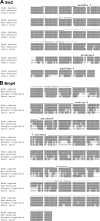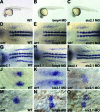SIX2 and BMP4 mutations associate with anomalous kidney development
- PMID: 18305125
- PMCID: PMC2386720
- DOI: 10.1681/ASN.2006111282
SIX2 and BMP4 mutations associate with anomalous kidney development
Abstract
Renal hypodysplasia (RHD) is characterized by reduced kidney size and/or maldevelopment of the renal tissue following abnormal organogenesis. Mutations in renal developmental genes have been identified in a subset of affected individuals. Here, we report the first mutations in BMP4 and SIX2 identified in patients with RHD. We detected 3 BMP4 mutations in 5 RHD patients, and 3 SIX2 mutations in 5 different RHD patients. Overexpression assays in zebrafish demonstrated that these mutations affect the function of Bmp4 and Six2 in vivo. Overexpression of zebrafish six2.1 and bmp4 resulted in dorsalization and ventralization, respectively, suggesting opposing roles in mesendoderm formation. When mutant constructs containing the identified human mutations were overexpressed instead, these effects were attenuated. Morpholino knockdown of bmp4 and six2.1 affected glomerulogenesis, suggesting specific roles for these genes in the formation of the pronephros. In summary, these studies implicate conserved roles for Six2 and Bmp4 in the development of the renal system. Defects in these proteins could affect kidney development at multiple stages, leading to the congenital anomalies observed in patients with RHD.
Figures







Comment in
-
Some assembly required: renal hypodysplasia and the problem with faulty parts.J Am Soc Nephrol. 2008 May;19(5):834-6. doi: 10.1681/ASN.2008030281. Epub 2008 Apr 2. J Am Soc Nephrol. 2008. PMID: 18385415 No abstract available.
References
-
- Woolf AS: A molecular and genetic view of human renal and urinary tract malformations. Kidney Int 58: 500–512, 2000 - PubMed
-
- Woolf AS, Price KL, Scambler PJ, Winyard PJ: Evolving concepts in human renal dysplasia. J Am Soc Nephrol 15: 998–1007, 2004 - PubMed
-
- Piscione TD, Rosenblum ND: The molecular control of renal branching morphogenesis: current knowledge and emerging insights. Differentiation 70: 227–246, 2002 - PubMed
-
- Ghanbari H, Seo HC, Fjose A, Brandli AW: Molecular cloning and embryonic expression of Xenopus Six homeobox genes. Mech Dev 101: 271–277, 2001 - PubMed
Publication types
MeSH terms
Substances
LinkOut - more resources
Full Text Sources
Other Literature Sources
Molecular Biology Databases

